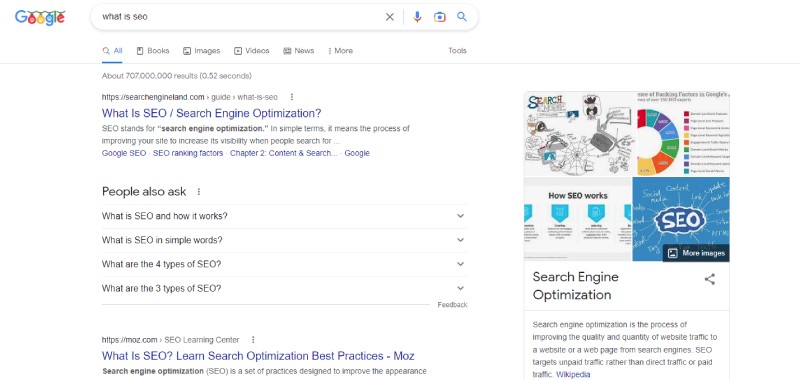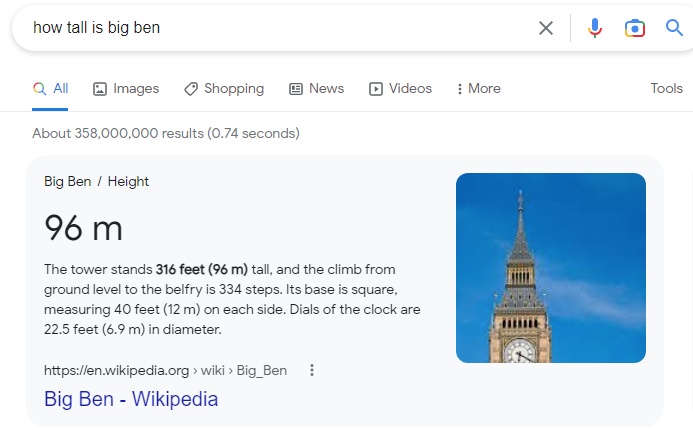SEO is forever changing. Whether it’s a new Google update, or changes in search behaviour, marketers must constantly adapt their SEO strategies to achieve that all-important SERPs ranking.
As a new year approaches, now is the perfect time to update your SEO strategy for 2023.
Keep reading to discover the latest SEO ranking signals and tips to improve your visibility in search engines results pages (SERPs).
Table of Contents
- 2022: the year of updates
- Key Google updates in 2022 included
- What do Googles’ updates mean for SEO in 2023?
- How to improve your search ranking in 2023
- 1. Create content that is topic-focused rather than keyword-focused
- 2. Optimise content for Google Featured Snippets & People Also Ask
- 3. Ensure a positive user experience with Core Web Vitals
- 4. Optimise content for accessibility
- 5. Benefit from local search & Google My Business profiles
- 6. Consider social SEO
- 7. Create content that satisfies Google’s EAT signals
- 8. Don’t neglect your blog
- 9. Use AI correctly
- 10. Prepare for GA4
- How can we help?
2022: the year of updates
In 2022, Google released several significant updates which were centred around improving users’ experiences and providing quality content.
Key Google updates in 2022 included:
-
Google’s Page Experience Update 2022 – Core Web Vitals ranking signals started applying to both mobile and desktop pages
-
May 2022 Core Update – Prioritising showing relevant content to users
-
Helpful Content Update 2022 – Increasing the visibility of original helpful content in search results, rewarding content written by humans for humans
-
September 2022 Product Reviews Update - Ensuring that people see in-depth, well-researched product reviews, rather than thin content that simply summarizes a range of products
-
October 2022 Spam algorithm update – Fighting spam in search results
What do Google's updates mean for SEO in 2023?
Google is clearly prioritising high-quality content that truly satisfies users’ queries. This means no more shortcuts in content – whether it’s keyword stuffing, surface-level, regurgitated content, or spam.
Instead, Google wants to see content made by humans, for humans, and is rewarding content that answers their users’ queries comprehensively.
They want to ensure their users have the best experience possible – and that means matching queries with content that truly solves their problems.
With this in mind, keep reading for our tips for a killer SEO strategy in 2023.
How to improve your search ranking in 2023
1. Create content that is topic-focused rather than keyword-focused
As search engines become more advanced – armed with an array of algorithms and language processing AI (think Google’s LaMDA, RankBrain, Neural matching, and BERT for starters) they can now understand complex queries and context behind a search term or piece of content. This is called semantic search.
As a result, content that simply uses an abundance of keywords without addressing topics in detail will fail to rank well in SERPs.
Instead, content should now be topic-focused rather than keyword focused, and address a range of related topics which users will find useful.
How to do this
-
Identify a topic you want to address, then think about the associated topics that users might find helpful for your content to address and include them as subheadings in your content
-
Make use of the People Also Ask feature in Google SERPs to find associated topics
-
Prioritise providing context around a piece of content – with metadata, related subheadings, internal links
-
Avoid keyword stuffing – focus on creating quality content that answers queries in-depth
2. Optimise content for Google Featured Snippets & People Also Ask
Google Snippets are an excellent way for your content to appear in the top-positions in SERPs.
Snippets are excerpts of content from a webpage which are displayed in Google SERPs above the website link instead of below. Snippets can appear on their own within overall search results, within the ‘People Also Ask’ section, or within Knowledge Graph information. The information in the snippet can be in a list format – taken from subheadings in an article, or simply a sentence or two answering a query.
Snippets are selected by Google’s algorithms if they think the format will help people find what they’re looking for more easily – both from the snippet and when they click through onto the page.


How to do this
To optimise content for snippet status – it’s important to think about how you can answer your audience’s questions in a succinct manner which directly addresses the question.
This includes incorporating question-style subheadings and answers below, creating content in a list format, or crafting an excellent conclusion which summarises the arguments or points you have made concisely.
You should also think about search intent – and what your customers will be searching for – and how you can answer these questions.
3. Ensure a positive user experience with Core Web Vitals
Following Google’s Page Experience Update in 2022 – desktop webpages are now subject to the same ranking factors that previously only applied to mobile pages. This means that Core Web Vitals metrics are an important part of your SEO strategy moving into 2023.
Core Web Vitals ensure users have a positive experience on your website. With only seconds to capture your visitors’ attention, your website needs to be fast, responsive and provide a positive experience.
CWV factors include:
-
First Contentful Paint (FCP): how quickly content loads on your website.
-
First Input Delay (FID): how quickly a webpage processes an interaction on your website from a user
-
Largest Contentful Paint (LCP): how long it takes for the largest piece of content to load and appear on your website
-
Cumulative Layout Shift (CLS): the number of layout shifts that occur on your website without user interaction.
How to do this
-
Use insights from the Core Web Vitals report to make adjustments to your website
-
Remove any interstitials on your website (ads that pop up while a page is loading)
-
Compress images to ensure quick loading time
4. Optimise content for accessibility
Google wants to ensure all of their users can find what they need, including those with disabilities who may require additional information to understand the context behind a piece of content.
This means that your SEO strategy needs to include accessibility. Not only will this help the roughly 1 billion people living with some form of disability worldwide access the information they need to, but because of Google’s commitment to accessibility – it will improve your SEO ranking too.
How to do this
-
Add alt text to images – and really describe what they are portraying
-
Add subtitles to videos
-
Add markups / tags to videos – showing the different parts of the video
-
Split up content with subheadings to make them scannable and more easily digestible
-
Save image files with descriptive names – including keywords if relevant
5. Benefit from local search & Google My Business profiles
With free tools such as Google Business Profile (formerly Google My Business), and ‘near me’ searches still popular with users, local SEO is an excellent way to appear higher in SERPs for customers in your business’ area.
Search engines can now identify users’ localised context such as location, time of day, and previous searches - and apply this context to the results it shows, meaning that location-specific content and optimised Google Business Profiles should be incorporated into your SEO strategy for an additional chance to appear in search results.
How to do this
-
Create localised content on your website by including location names or location-specific topics
-
Achieve backlinks from local businesses with high authority
-
Optimise your Google Business Profile by - adding all of your service areas, mentioning your location in the business description, adding opening times, and keeping it as updated as possible
6. Consider social SEO
According to research, more and more users (particularly gen z) are using social media platforms as search engines [Source].
This change in user behaviour not only impacts the way search queries are formulated (i.e. more visually descriptive terms, shorter search queries, trend related queries), but also the way users expect to see products or services advertised.
Although social media presence doesn’t directly impact your SEO ranking, it can indirectly improve your visibility – and trust in your brand.
For example, consumers are more likely to buy from a product page that includes photos from real peoples’ social media accounts [SproutSocial].
Not only this, but likes, shares and comments all send trust signals to customers – therefore increasing the chances of users searching for your brand, arriving on your website, and ranking your website higher.
How to do this
-
Think about how and why users would search for content on a social platform – e.g. their searches might be trend-related, descriptive (colours, shapes, styles etc), or inspiration-driven – then create website content which appeals to this
-
Incorporate descriptive language in metadata, product/service descriptions and alt text – i.e., colours, style, trending keywords
-
Link to website content on social channels and include hashtags for it to be found more easily
7. Create content that satisfies Google’s EAT signals
Google’s E-A-T signals are outlined in their Search Quality Rater Guidelines and require content to show: Expertise, Authoritativeness, Trustworthiness to rank well in SERPs.
What does this mean?
-
Expertise – Refers to how well-versed the website/author is in the topics being addressed – i.e. it’s not a beauty blog writing about health advice
-
Authority – Refers to the reputation of the website/author in their industry – this includes authority score and backlink profile
-
Trustworthiness – Refers to whether the website/author provides factual accuracy. This can be in the form of cited sources, named author, and other trust signals such as secure connection (HTTPS)
These signals particularly apply to websites that fall under the YMYL (Your Money, Your Life) category of businesses that can directly impact an individuals’ health, happiness, safety, or financial stability, such as medical practitioners or financial advisors.
However websites of all categories should refer to the EAT signals when producing content to help it rank higher in SERPs.
How to do this
-
Don’t write about topics that aren’t relevant to your business
-
Back up data with statistics and facts – from authoritative websites such as .edu and .gov
-
Display customer reviews and testimonials
-
Acquire backlinks from authoritative websites
-
Create detailed content which addresses related topics in-depth
8. Don’t neglect your blog
If we can learn anything from Google’s many updates in 2022, it’s that content is still king, and this means that blogs are still very much alive as we move into 2023.
Whilst blogs may not serve as a key converter, they are an excellent way for users to find your website in SERPs, drive customers down the buying funnel, and reduce reliance on one particular channel should it ever go down or become less effective.
The important thing to remember is that your content MUST be written with your customer in mind and truly solve their problems. As with the Helpful Content Update, it’s essential that the content you add to your blog is valuable, original, and written for humans.
How to do this
-
Conduct content research to identify popular search queries from your target audience and create content that answers them
-
Think about user intent – and create content that satisfies each user intent (informational, transactional, and navigational)
-
Prioritise in-depth longform content
-
Have a purpose to your blog posts – say something original that others aren’t saying
-
Include strong CTAs in your blog content
-
Diversify your blog content – whitepapers, downloadable content, infographics
9. Use AI correctly
In light of Google’s Helpful Content update – which explicitly states that it rewards content that is written ‘for humans, by humans’, the jury is still out regarding AI content writers.
Having tested AI tools here at TDMP, it was clear that they could never create the in-depth, original content that is vital for SEO – and therefore we would argue that AI content writers should NOT form part of your 2023 SEO strategy, despite platforms’ assertions that they are great for SEO.
This being said, AI is undoubtedly a core part of SEO – with Google and other search engines relying almost entirely on AI to decide where your content ranks in SERPs.
This means that SEOs need to understand how to harness AI in their favour – without falling foul of Google’s fight against artificial content.
How to do this
-
Evaluate how detailed, human, and original the content from AI writers really is before using them
-
Use AI tools to help with SEO tasks such as
-
keyword research
-
topic research
-
optimise content
-
determine how similar your content is to other websites
-
identify competitors
-
10. Prepare for GA4
Finally, Universal Analytics will no longer collect data after July 2023, so SEOs and website owners need to make sure they are ready for the switch over.
Find out more about how marketing attribution is changing with GA4 here.
How to do this
-
If you haven’t already you should sign up to GA4 and set up your accounts so that they are tracking data before the switch takes place
-
Learn GA4’s new metrics – see Google’s guidance on the differences here
-
Get used to the new interface & functionality
-
Test the reporting function
-
Update your tagging structure in GA4
How can we help?
If you need help improving your visibility in SERPs, or simply require advice for an SEO project you have, contact TDMP today.

